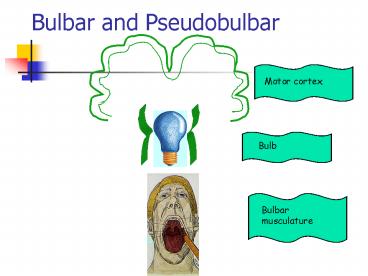Bulbar and Pseudobulbar - PowerPoint PPT Presentation
1 / 14
Title:
Bulbar and Pseudobulbar
Description:
Corticobulbar terminates at brainstem motor nuclei ... Dysarthria, dysphagia, emotional lability, cognitive changes/higher level function impairments ... – PowerPoint PPT presentation
Number of Views:601
Avg rating:3.0/5.0
Title: Bulbar and Pseudobulbar
1
Bulbar and Pseudobulbar
2
Terminology Pathways
- UMN
- Includes corticospinal corticobulbar tracts
- Corticospinal terminates at spinal motor nuclei
- Most provide contralateral influence
- Corticobulbar terminates at brainstem motor
nuclei - Most corticobulbar tracts provide some bilateral
influence
3
Corticobulbar and Corticospinal Pathways
4
Terminology Pathways
- Upper Motor Neurons (UMN)
- Direct activation pathway (conscious, skilled
behaviors) - Pyramidal (pyramid shape) pathway
- Mostly crossingdirect activation pathway
5
Terminology Pathways
- Upper Motor Neurons (UMN)
- Indirect activation pathway (subconscious,
automatic) - Extra-pyramidal pathway
- Intermingled with pyramidal
- Contralateral predominanceindirect activation
pathway
6
Direct and Indirect Activation
7
Terminology Pathways
- LMNlower motor neuron
- final common pathway
- In both CNS and PNS
- Cell bodies in CNS
- Cranial and spinal nerves in PNS
- Motor unit LMN muscle fibers innervated by it
8
Motor Unit
9
Terminology LMN
- Alpha motor neurons
- Innervate extrafusal muscle fiberscontractile
element of muscle (from brainstem or spinal cord) - ? motor neurons activated by direct activation
pathways - Gamma motor neurons
- Innervate intrafusal muscle fibers (muscle
spindles) - Intrafusal fibers parallel to extrafusal fibers
- Regulate reflexes and maintain muscle tone
posture - ? motor neurons activated by indirect activation
pathways
10
Terminology of Impairment
- Bulbar
- Unilateral or bilateral LMN and/or sensory
- Dysarthria, dysphagia, possible
respiratory/cardiac changes - Flaccid, loss of reflexes
- Atrophy, fasciculations
11
Terminology of Impairment
- Pseudobulbar
- Bilateral UMN
- Dysarthria, dysphagia, emotional lability,
cognitive changes/higher level function
impairments - Spastic, hyperactive reflexes, pathologic
reflexes - Tightness, slowness, contracture
12
Supratentorium Cortical Forebrain Supranuclear
Bulbar Brainstem Hindbrain Nuclear
13
UMN and LMN Influence
14
Critical Points
- Know the difference between UMNs and LMNs
- Know the 2 pathways of the UMN system
- Know the 2 types of LMNs
- Know the various terms that apply to brain
regions - Differentiate bulbar from pseudobulbar by
characteristics of the impairments

